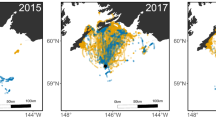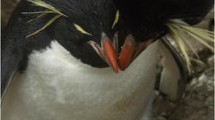Abstract
We conducted a manipulative experiment to investigate how raising chicks affects the body condition (body mass scaled by body size) and body composition (percent fat vs. lean mass) of black-legged kittiwakes (Rissa tridactyla). For 4 consecutive years (1991–1994) we removed eggs from randomly selected nests and then compared adults raising chicks with adults that had their eggs removed. At the end of the chick-rearing period, adults raising chicks were significantly lighter for their size than adults that had their eggs removed. Adults raising chicks also had a significantly lower percent body fat (by 28%) than adults from manipulated nests. The difference in percent body fat between the two groups was apparent at all levels of condition, suggesting that adults that are raising chicks apportion their reserves differently than adults that are working only to meet their own metabolic needs. End-of-season body condition of adults from manipulated and unmanipulated nests varied significantly among 5 years of study, and appeared to reflect differences in local foraging conditions. In all years, females were in worse condition than males at the end of the breeding season. This sex-specific condition difference did not, however, appear to indicate a greater short-term reproductive cost among females. Females were lighter for their size than males in both the manipulated and unmanipulated groups. Our results suggest that adult kittiwakes compromise their body condition and body composition during chick rearing to increase the likelihood of successfully fledging young, even though such adjustments may decrease their own post-reproductive survival probabilities. Prior to estimating the body composition of the experimental birds, we evaluated the usefulness of several noninvasive techniques for predicting fat mass in kittiwakes. We used cross-validation techniques to compare multiple regression models that included total body electrical conductivity (TOBEC), total body water (TBW), and morphometric measurements as independent variables. The most parsimonious model for predicting fat mass was based on TOBEC and mass measurements. TBW and morphometrics were of little utility in predicting fat mass in kittiwakes. Previous studies that have evaluated the usefulness of TOBEC as a predictor of fat mass have shown mixed results. We suggest that the size of the experimental subject relative to the size of the TOBEC measurement chamber may affect the accuracy of this technique.
Similar content being viewed by others
Author information
Authors and Affiliations
Additional information
Received: 30 November 1998 / Accepted: 29 April 1999
Rights and permissions
About this article
Cite this article
Golet, G., Irons, D. Raising young reduces body condition and fat stores in black-legged kittiwakes. Oecologia 120, 530–538 (1999). https://doi.org/10.1007/s004420050887
Issue Date:
DOI: https://doi.org/10.1007/s004420050887




